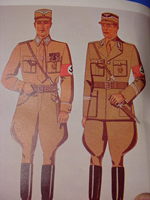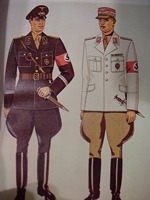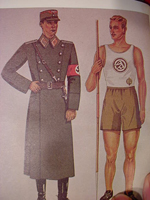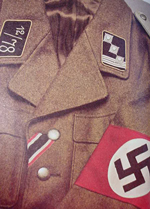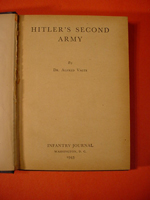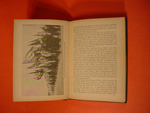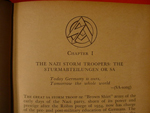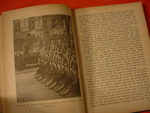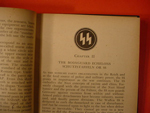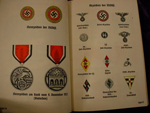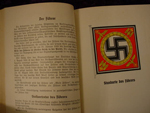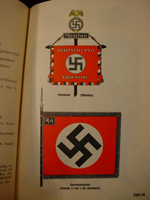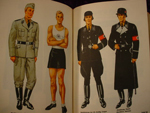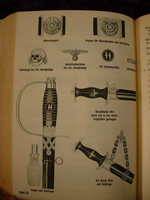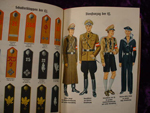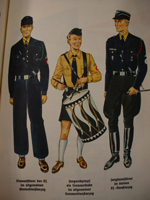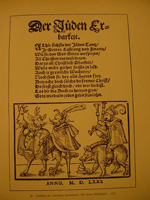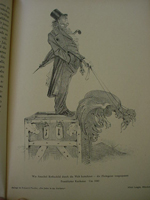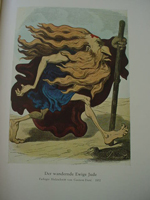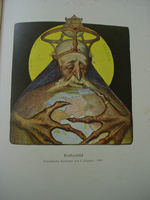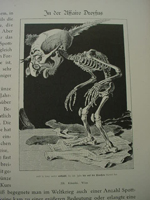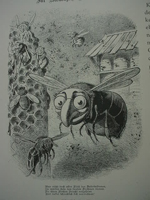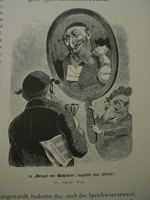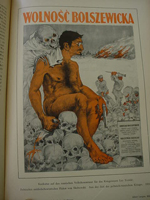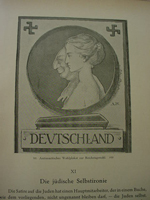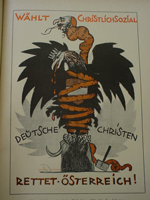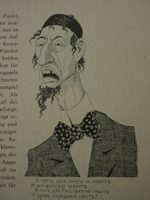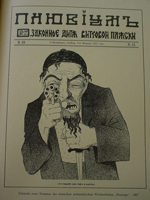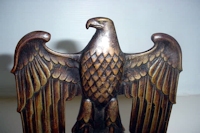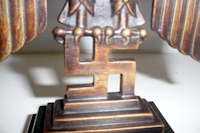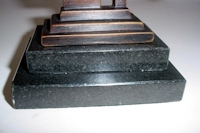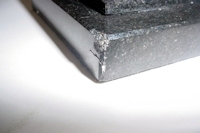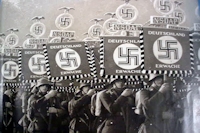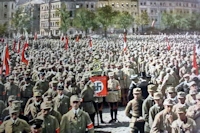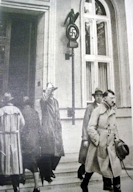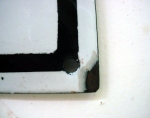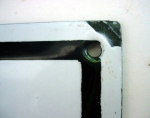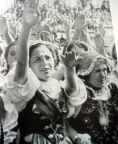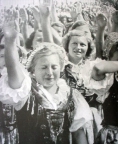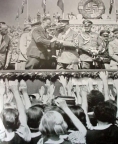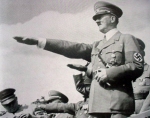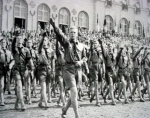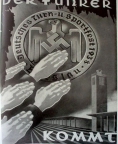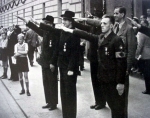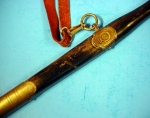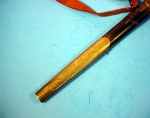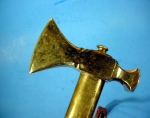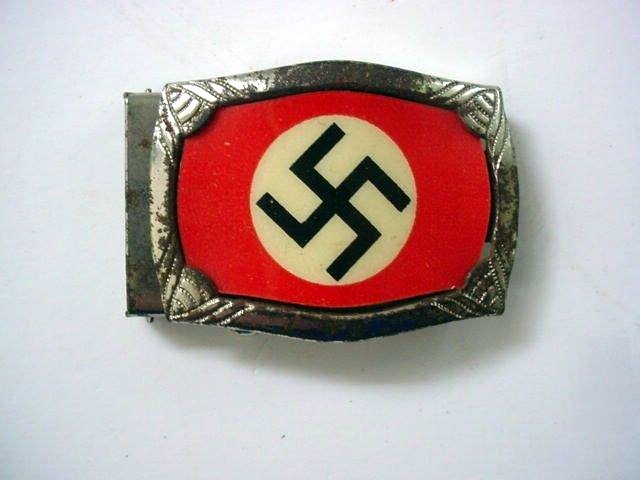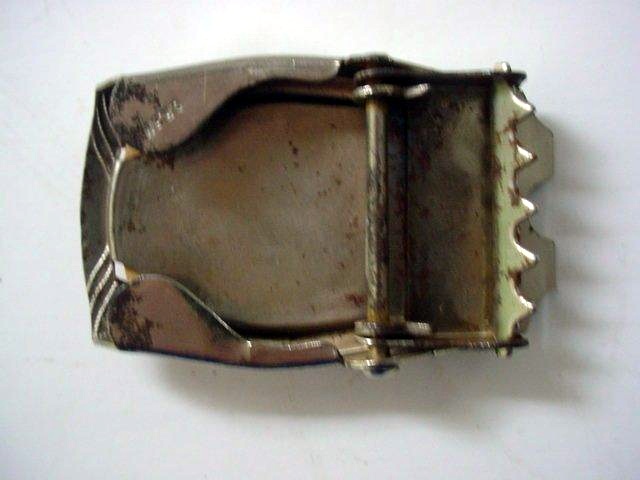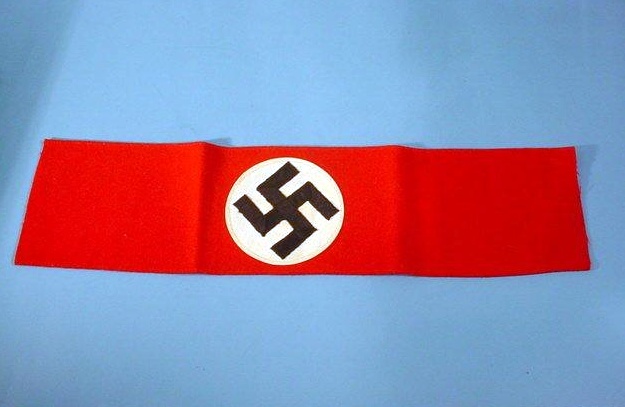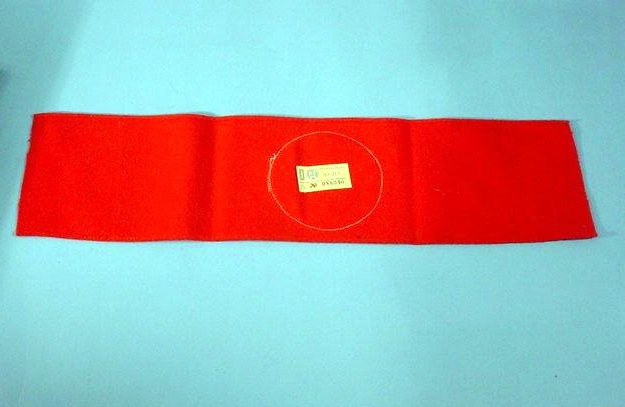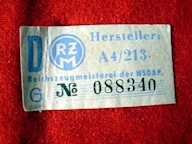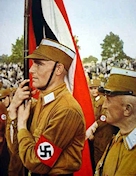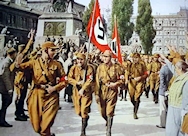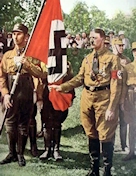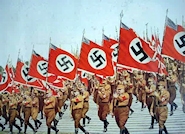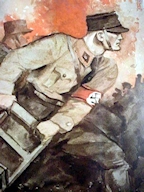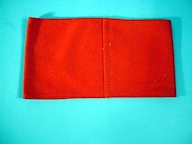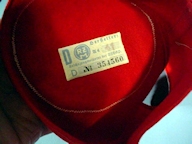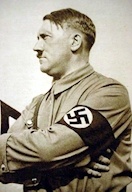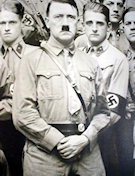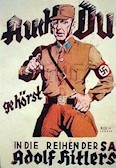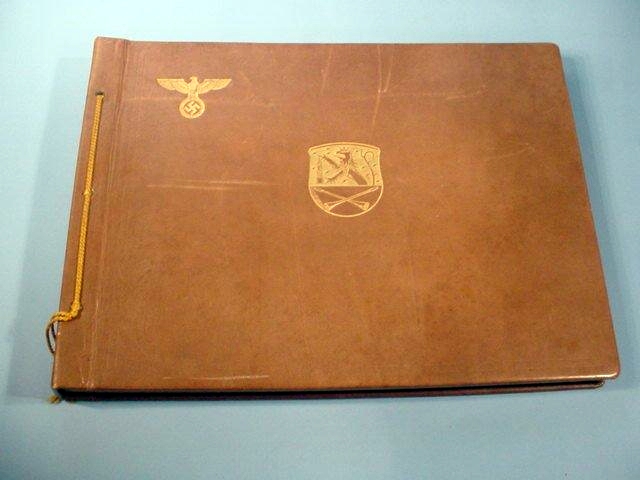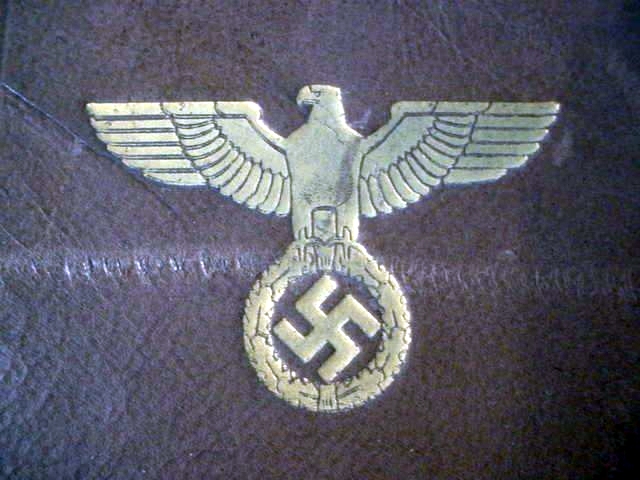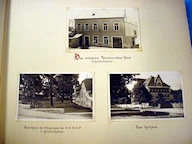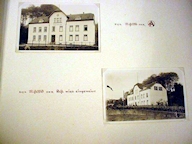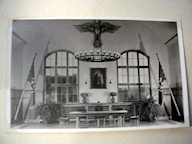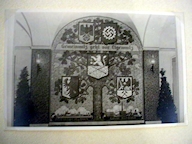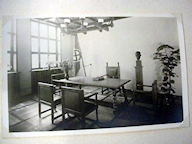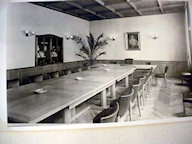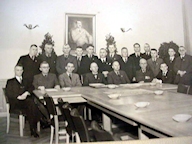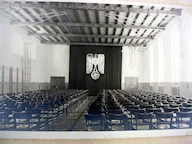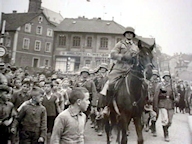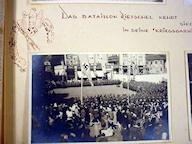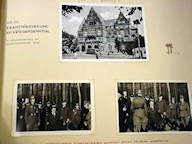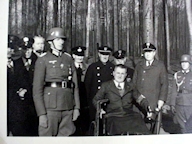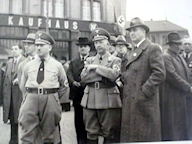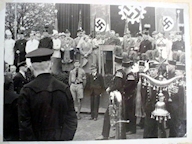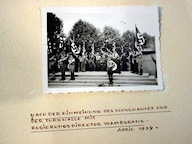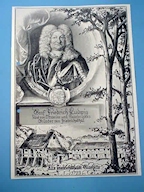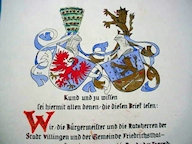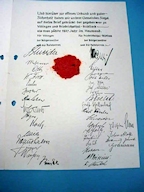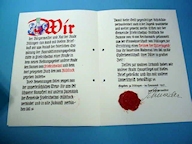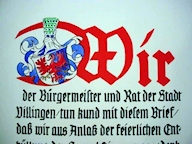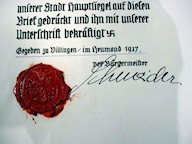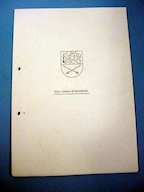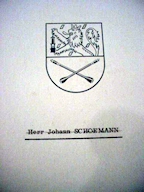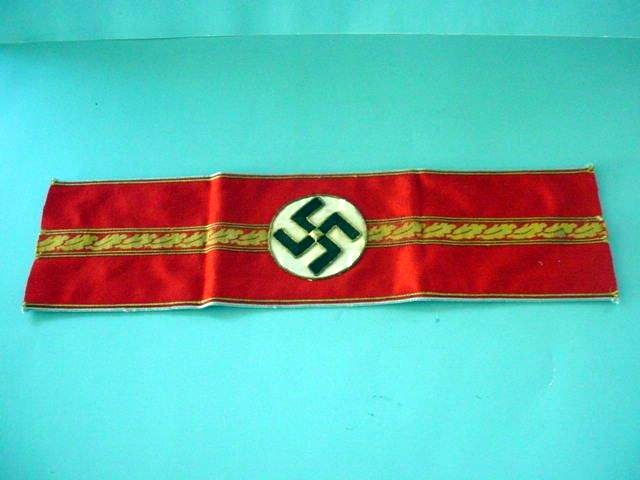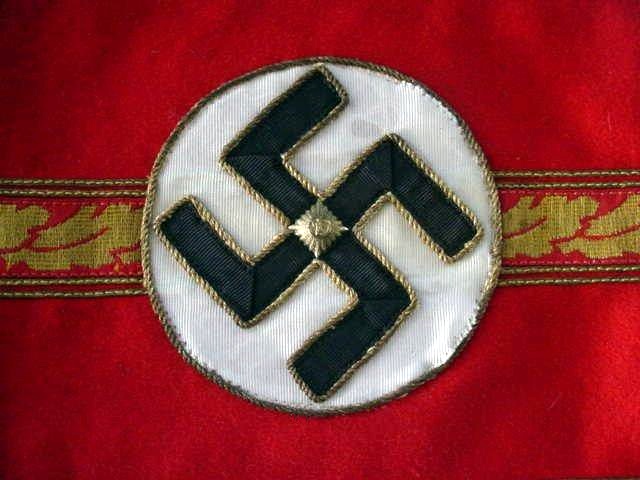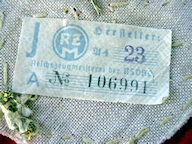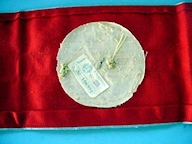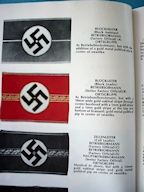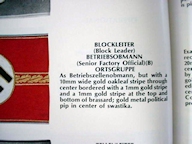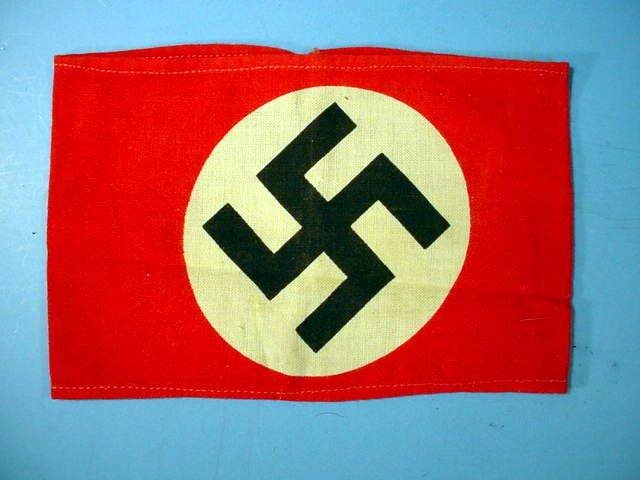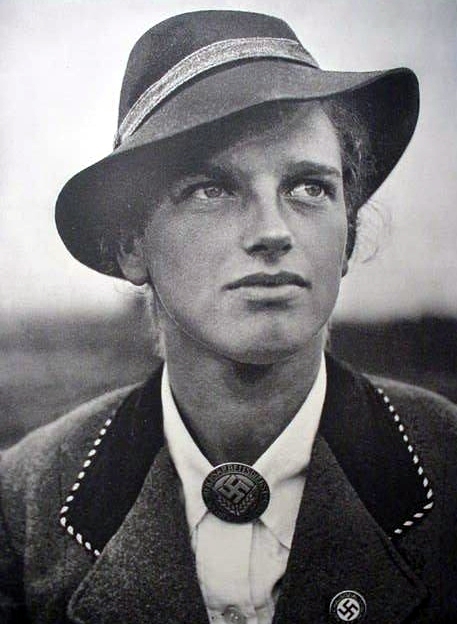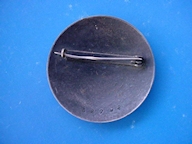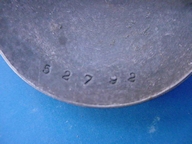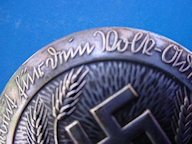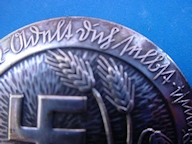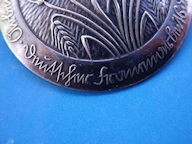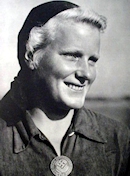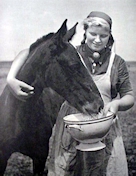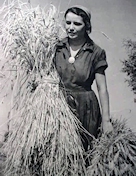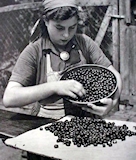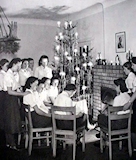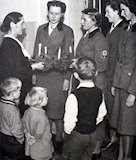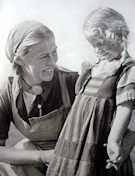|
|
|
|
N.S.D.A.P.
The Nazi Party
Page 19
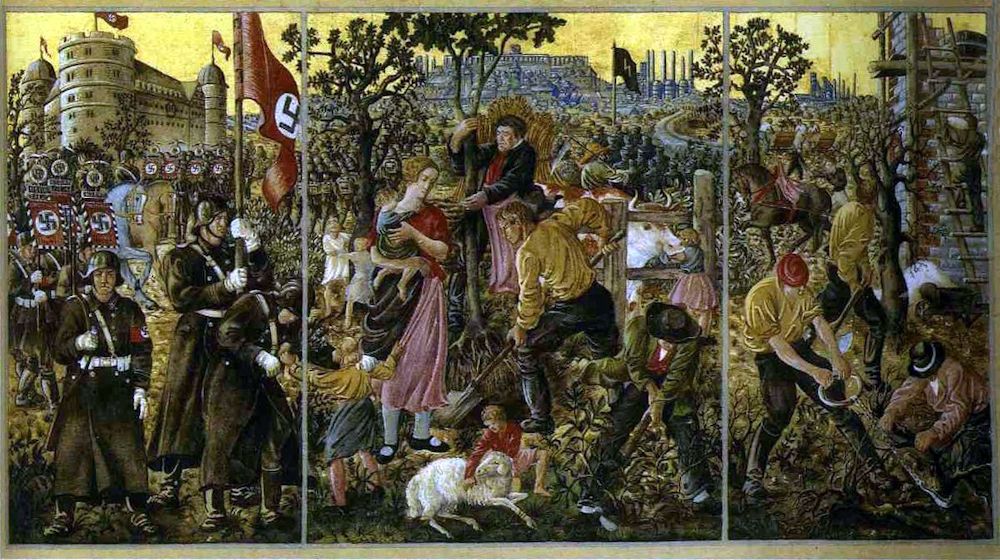
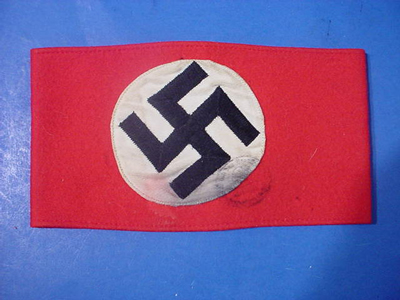 |
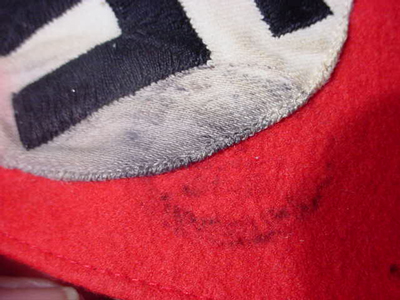 Light stamp |
|
Armband of the NSDAP (Item NSDAP 19-1)
|
|
DESCRIPTION: This is the typical woolen armband in three piece construction. White field with black swastika on the red band like so many others of this variety it had a stamp barely visible on the front. The stamp probably identified the section of a Kreiss that the wearer belonged to but it is faded now and unrecognizable, there are about three small moth holes that are not too noticeable. The band is 100% original to the period...not like ones on certain other sites. PRICE: SOLD |
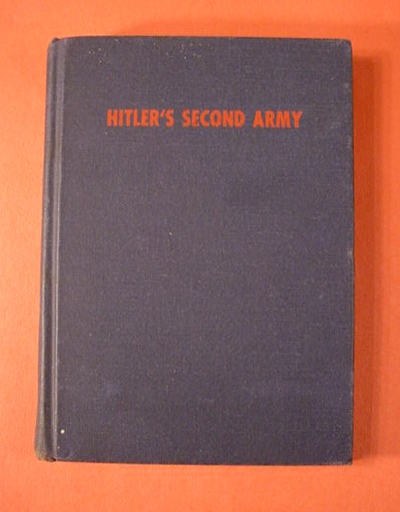 |
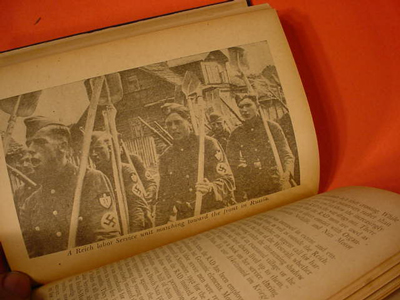 |
|
Book: Hitler’s Second Army – Infantry Journal 1943 (Item NSDAP 19-3)
|
|
DESCRIPTION: This was published in Washington D.C. in 1943 and written by Dr. Alfred Vagts with a forward by Germanophobe Col. Joseph Greene the editor of the Infantry Journal. The book claims that the para-military organizations of the Third Reich would be a backup for the Wehrmacht if an invasion for the destruction of Germany is to be accomplished. Greene uses various NSDAP publications in his murderous plans. He gives an accurate description of the organization, use, and tactics of most of the groupings that made up the German N.S. infrastructure. He has various chapters of the book devoted to studies of the SA, SS, NSKK, NSFK, OT, TENO, RAD, NSKOV HJ, NS Frauenshaft, RLB and NSV. This is mostly information taken from the organization book of the NSDAP and not from the intellectual aplomb of this Colonel Greene. The book, however, is important in that the translations are there (not by the hand of Greene) and the book is rare at the same time being a preview of the planned genocide against Germany and its institutions. It succeeded as we know and are we better off today due to its success? The book is comprised of 241 pages and measures 5x7; the pages are slightly yellow with age but the condition is generally good. PRICE: $95.00 |
 |
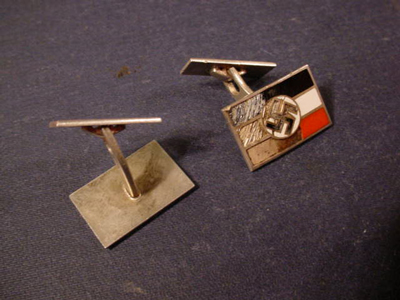 |
|
Pair of N.S. Cufflinks in Enamel (Item NSDAP 19-4)
|
|
DESCRIPTION: This was a beautiful set of cufflinks featuring the “Hakenkreuz” or swastika and the colors of Germany (black, white, red). They would be a very expensive set of great Nazi Kitsch items were it not for the fact that one of them was badly damaged and though that is a pity, they are still a historically important original set of “Manschettenknopfe” (cufflinks) at a great price for the collector of pre-war N.S. items PRICE: $185.00 -- if perfect these would fetch upwards of $350.00 |
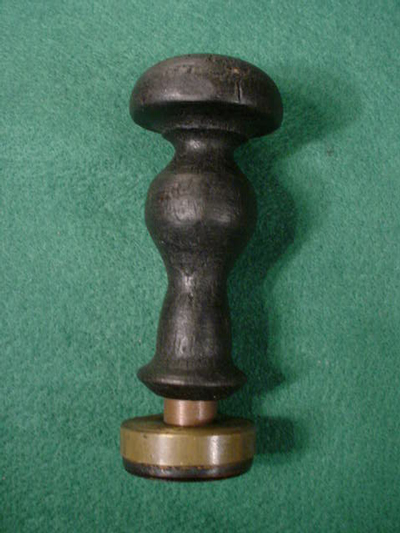 |
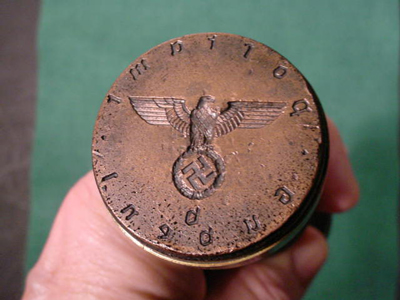 |
|
Post Office Wax Stamp from the Guben Post Office (Item NSDAP 19-5)
|
|
DESCRIPTION: This is a stamp for sealing an official letter envelope from the small town of Guben in the Brandenberg district. An old town founded in 1200. The brass stamp is mounted in a wooden post designed to fit comfortably in the hand when sealing the official important document. A rather rare and original Reich relic seldom seen or acquired yet an important historical addition to a collection of Third Reich items. PRICE: $175.00 |
 |
 |
|
The Organization Book of the National Socialist Workers Party (Organizationsbuch Der NSDAP) (Item NSDAP 19-6) |
|
DESCRIPTON: This was the handbook of the Nazi Party. This was the 600 page volume that was published by Reichsorganistionleiter Dr. Robert Ley. This book was never merchandised to the public; it was only distributed to officials from Gauleiters to block leaders and was the official rules and uniform regulations of the Party. Ever since I first became infatuated with the N.S. saga, I yearned to have a copy of this rare book and when the hobby got going to full speed throughout the world in the late 50’s and 60’s. This book and the chained SS dagger were the most sought after 3rd Reich Relics of all! And the price was rather astounding back then. To own one was a status symbol personified with the relic hunters. Still today it is considered a great accomplishment indeed to land one of these archival treasures but the price comparatively has indeed come down to reasonable proportions. This is the 1937 edition that is considered the rarest of them all since it was the year of complete N. S. victory since it was the concluding year of the brilliant four year plan and Germany had turned into a virtual Aryan paradise! The book depicts the uniforms and other regalia of all branches of the N.S. State. In gorgeous color, flags, banners, uniforms, awards, political signs, all are displayed. No other book ever published then or now covers the subject more deeply or effectively. The volume's spine is a bit frayed about half way down the seam and the book is in well used condition but holding well. A little bit soiled but that’s not unusual for a 74 year old text book. Such books were used! They did not sit on a shelf looking pretty. Inside the front cover written by hand in red pencil it says – ‘P.G.—(Parteigenosen)’ “party comrade L-Ahrens Hamburg 36 and something about kamp 56/1. The book measures 6 x 8 ½ inches and is 1- ½ inches thick. The pages are in great shape and the color plates astounding. PRICE: Removed by consignor. |
 |
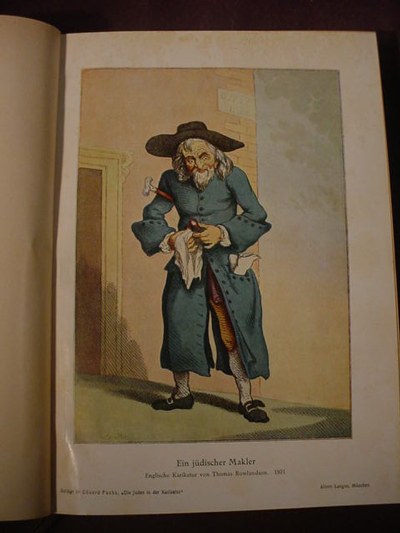 |
|
Book: Die Juden in Der Karikature Eine Beitrag zur Kulturgeshchichte (Item NSDAP 19-7) |
|
DESCRIPTION: This book is titled the Jew in Caricature, A Contribution to Cultural History by Eduard Fuchs. E. Fuchs was a German Marxist scholar of culture and history, a writer, art collector and political activist. He was jailed several times as a literary agitator. He wrote numerous inflammatory articles against the Kaiser and his government. During his periods of confinement Fuchs wrote various social histories utilizing images (karikatur) as one of his primary sources. He wrote a famous Magnum Opus (Sittengeschicte) that was an expose of various immoral practices in sex. Later he did a book Der Frau In Karikatur (3 volumes) and his most famous of all was the satire on the Jews called Die Juden in der Karikatur issues. Fuchs was a pacifist during WWI and then Lenin’s government put him in charge of prisoner exchanges with Germany after the war. He was among the criminals who made up the Commenters in Berlin in 1919. He resigned from the Party in 1929 and when Adolf Hitler came to power in 1933 Fuchs high-tailed it to France. However, other than the fact that he was a Communist, Hitler would have and probably did get a chuckle out of his stereotypical representations of the Jews. This was one of the volumes of books that we managed to buy that were a sold at a special showing of books of the NSDAP at the Frankfurt book fair a few years back. The book is in a large 11 x 8" format and is in great shape except for a few spots on the cover illustration -- 312 pages with 307 illustrations and numerous black and white and color illustrations. Published in 1921. The author shows in vivid photographs the history of anti-Semitism in every culture and time. Even Julius Streicher’s cartoons did not reach this level of levity. But Fuchs was not hung for them! He starts with documents and stone cuttings from Christian Church sources that allude to the unclean and thieving ways of the Chosen (not my words, Folks!). Other than the antique items most of the pictures are to the greatest extent absurd and hilarious! Many of these caricatures still stand such as at Notre Dame Cathedral in Paris. Pictures and text dealing with jibes at supposed Preoccupation with exotic sex perversions, Demonology, money grubbing, cheating, blasphemy and ugly countenance are blatantly perceived through artistic and comic presentation some rather vulgar, some absolutely hilarious. Again this is not a Nazi publication and it is believed that Fuchs was possibly Jewish himself. I have shown this book to three of my Jewish friends and customers and they loved it .No one appreciates Jewish jokes more that Jewish people .Political Zionist activists however will not care for it at all. If one does not read German (machts nicht!) the pictures are worth a thousand laughs. This is a very rare book. PRICE: $350.00 |
 |
 |
|
Bronze Wehrmacht and Party Eagle Desk Piece (Item NSDAP 19-8; ART 17-8; BRONZE 2-7) |
|
DESCRIPTION: Here is a magnificent sculpture in rich patinated bronze of the mighty German Hoheitsabzeichen or National Eagle. This configuration is different in that the eagle is perched upon a stationary swastika, not the usual mobile form. In the early days of the National Socialist movement this usage of the symbol was seen quite as much as the mobile form. This is one of the wonderful bronze sculptures that we managed to locate and purchase in the Gleiwitzdistrict near Berlin. See the Reichsparteitag Eagles at Partei 2-10. Here it explains how all the bronze sculptures came into our possession and this is one of the Prussian Bergwerk greats! The eagle on its double granite base is 9 ½ inches high. The actual bronze being 8 inches high. The wingspan is 6 inches. The depiction is spectacular embodying the mythos and spirit of the Third Reich like no other art object of the time. Strength, defiance, and majesty are apparent in the bold look of this magnificent sculpture. The base in granite was added later because the foundry had to order them separately in the 1930’s and 1940’s. We managed to find the marble quarry nearby that supplied the foundry in those days and we purchased plinths exactly like the originals that the eagles were mounted on. There might be a minor chip here and there (but certainly minor). These eagles were ordered by German army, navy, air force, and political-office groups as the ultimate desk ornament that portrayed national pride—and that it certainly does convey. No symbol of ultimate authority and nationalistic fervor ever existed that so graphically conveys such historical grandeur “Flieg Deutscher Adler, Flieg! (Fly German Eagle, Fly!)—from the NS song book . There is no artist’s signature on these eagles, but we suspect that they are by Herr Kurt Schmidt Ehmen the “Adlermeister” of the Third Reich. Also see the Eagle of the German Pavilion at Partei 2-11. We have only three of these; so don’t hesitate! PRICE: SOLD |
|
|
|
NS Patriotic, Enameled Sign (Item NSDAP 19-9 and SA 14-15) |
|
DESCRIPTION: This is an enamel sign with the words Unser Gruss ist “Heil Hitler!” - Our Greeting is “Heil Hitler.” These signs were purchased by fervently loyal party members and supporters in the Third Reich era. Private homes, apartment complexes, shops, and schools were places where such signs were prominently and proudly displayed. Hitler was to them the Messiah who brought them Arbeit und Brot (Work and Bread). His Four-Year Plan was a miraculous task that was successfully fulfilled from 1936-1940. The signs were manufactured in 1939 and displayed far and wide in the Reich right up to the end of the war. The Führer was probably the most revered leader of a people that this world ever knew. This was the opinion of the German ‘Volk’ and as you can see, they demonstrated it! The sign is 100-percent original with the deep-dish-indented backing (not the English copy that is FLAT!). It measures 1 foot by 20 inches and is in perfect condition except for tiny chips at two of the corner edges. Here is an item that is extremely rare today. Practically all were destroyed by warfare and the actions of the “Kulturträger.” PRICE: SOLD |
 |
|
Dress Fire Department Ax from the Saar Louis-Graf Werder Kaserne (Item NSDAP 19-10; WEHR 32-10) |
|
DESCRIPTION: This is a traditional dress-parade fire ax as worn in ceremonial occasions at the famed Saar Louis Kaserne (camp) of the Wehrmacht in the center of the Saarlands by Zweibrucken. This is today the main training camp for the German Army (Bundeswehr). The camp was originally built in the Reich of Louis XIV, but it came under the Peace of Paris to Prussia and they enlarged the fortifications. When the Prussians took over, the barracks was named Graf Werder Kaserne; named after Karl Wilhelm Friedrich August Graf (Count Von Werder), who was a famed Prussian general who greatly distinguished himself in the Austrian-Prussian War of 1866 at Königgrätz. Later, in the Franco-Prussian War, he captured Strasbourg after a long and famous siege. The compound was so big (like a city) it had all the institutions that would be necessary for a social and business situation; it had its own banks, theatres, hospitals, police barracks, and fire department. These firemen had special dress uniforms and musical bandsmen. They sported special regalia for their ceremonial events to include the dress fire ax similar to the ones used by other such functionaries throughout the Kaiser Reich and the Third Reich. Actually, the tradition goes back much farther than that. The ax that we feature here is a long one (longer than most); it’s 22 ½ inches long. The ax head is 5 inches long, the medallion in the center of the handle is 1 ¾ inches high and 1 inch in width. The medallion is in brass and says: “Saarlouis 1936 (Graf Weder).” It has the crown of a Count (Graf) in Prussian nobility with the (“W”) for Werder in a wreath, and below this the Hakenkreuz (swastika). The ax head shows lots of plating corrosion, but this was natural in these thinly plated items after years of use; deterioration is expected. The ax is generally in good shape overall and is a rare Reich relic on its own. This is a true museum piece from a famed military community and tradition. PRICE: SOLD |
|
||
|
Unusual Belt Buckle (Item NSDAP 19-11; G-ABUND 1-12) |
||
| DESCRIPTION: Here is an interesting buckle that, so far, is unattributed. I have seen two of them in as
many years, so they are indeed rare. There has been much speculation about them. Some feel they are the earliest form of buckle worn by the various
party leaders in the early 20’s, while others believe them to be made in Germany and used by the members of the German American Bund. The N.S.
connection is obvious with the pattern of colors and layout of the swastika and this one is marked with the typical “DRGM.” They are rather cheaply
made with a tin-based metal, while the red field with swastika is in celluloid framed inside the buckle’s surface. The attachment that secures it to
the leather belt (or perhaps cloth belt) is of the style of dress belts of the commercial grade in the 20’s and 30’s; nothing like the uniform belts
of the later party and military. We recently found two of them; one is a tiny bit smaller than the other. The smaller one described here is marked
with the “DRGM” and has a slight bit of décor around its edges. The fact that the other one is plain and bigger indicates to us that possibly they
were made by two different companies. For the advanced collector of buckles, these pieces are to be considered very rare.
PRICE: SOLD |
|
||
|
Unusual Belt Buckle (Item NSDAP 19-12; G-ABUND 1-13) |
||
| DESCRIPTION: This is the larger of the two buckles we recently found. This one is slightly larger and has
no edge décor. It does have the "DRGM" marking that can be seen, although partially covered by old corrosion. The description other than for that is
exactly the same as the one above.
PRICE: SOLD |
|
|
|
|
National Socialist Armband (Item NSDAP 19-13; SA 14-18) |
| DESCRIPTION: This is a mint-condition N.S. armband of the top-of-the-line type. This is with white circle
machine stitched on red wool cloth. It has the multifold swastika in the center; the band is 100-percent original with the paper (RZM) tag inside.
The band is so minty that it obviously was not issued, because it was never joined by sewing attachment to a uniform. For those collectors that fear
latching onto a reproduction armband as often offered on other sites, here is the one you want. Just as nice and probably nicer an example as you
will ever find.
PRICE: SOLD |
|
|
|
|
NSDAP or SA Armband (Item NSDAP 19-14; SA 2-A) |
| DESCRIPTION: Here is the best one we have ever had over the years. There are armbands out there in cyber
land, but here is the epitome of N.S. armbands with the paper RZM tag within; this is usually a much sought-after “bonus” because even in some of the
finest originals offered, this tag is missing, and they always should appear in N.S.-issued bands. This band is about mint in condition. It has the
white banded, white circle mounted on red wool and the swastika is comprised of multilayered pieces of black strips of hard cotton overlay of over
seven pieces. This is the text-book issue N.S. armband and about the nicest you will ever see. Yes, it costs more than some of the inferior ones out
there and some of them are reproductions, but this one is 100-percent genuine and of the period.
PRICE: SOLD |
|
|
|
|
|
|
Fantastic Historically Important Album and Political Document Group (Item NSDAP 19-15; ALBUMS 3-9) |
| DESCRIPTION: The beautiful album begins with a dedication to party member Schoemann from the
Bürgermeister of the city of Friedrichsthal. The mayor says: “Party Comrade Schoemann, we hereby present to you in the name of the town
council this commemorative book on the occasion of your leaving Friedrichsthal.” He goes on to say: “May it be a piece of home for you and for us; it
is a great gift of thanks for your understanding and diligent work for all of us. It shall be a reminder of the tasks and fulfilled work in the
service of our organization—Heil Hitler!” Then the signature of the Bürgermeister (mayor), and under that it says: “Friedrichsthal on
28 December 1940.” Folded inside the cover are two beautiful hand-done calligraphy documents. The first is from the Bürgermeister of the town
of Villingen and it is from the aldermen of that town, as well. It says: “We, the officials of this town of Villingen, hereby announce with this
document that on the occasion of the inauguration of a memorial commemorating the Saar Plebiscite in Friedrichsthal we have therefore named a new
street after the city of Friedrichsthal and we have given the town square the name of Bildstock. The new names shall witness our brotherly connection
that has been in existence since the time of struggle and shall forever bear witness that the city of Friedrichsthal-Bildstock is connected with us
for the future. To show our eternal friendship so that it will enable our youth to continue in the same spirit, the town of Villingen has collected
the sum of 10,000 Reichsmarks to build a Hitler Youth Center. This document shall stand as proof of our gratitude and we declare this with our town
seal and signatures affixed in Villingen, June 1937.” At the end of the sentence is a tiny swastika instead of a period. Under this is the mayor’s
signature and the actual wax seal of the town. This document is inside a white folder with the town coat of arms and the name of the recipient
Herr Johann Schoemann. Each place a sentence ends, instead of a period there is a swastika. Also in this folder there is another official
hand-lettered (calligraphy) document; it’s lettered thusly: “Hark to all those who will read this proclamation! We the mayor and the aldermen of the
town of Villingen and the city of Friedrichsthal-Bildstock have come to an agreement to intertwine our bands of friendship in integrating our town
with Friedrichsthal-Bildstock, a friendship that has existed ever since the days of the Saar Plebiscite and we promise to help each other in times of
need now and in the future. We do this in the name of our Führer and the National Socialist movement and to demonstrate our loyalty to all of
our German Volk! To this pledge and with this document we shall adhere to and therefore set our signatures and seal that will bear witness to this in
Villingen and Friedrichsthal-Bildstock in the year 1937 in the month of June.” Signed—the Mayor and Aldermen of Villingen. And on the other side is
the mayor and aldermen of Friedrichsthal-Bildstock. Between them is the actual wax seal and on each side of the seal are columns of signatures; about
35 in all. The coats of arms of both the towns are in the heading; all hand drawn and painted in beautiful realism. They are joined as is befitting
the amalgamation of the towns and their officials. All of this and the funds mentioned were supplied by party member Johann Schoemann. He was a very
rich man about town in Friedrichsthal and he was now leaving Friedrichsthal and this was a sad farewell gift to him as he was the most favored son of
the city. The album has pictures of his simple house, and pictures of public buildings that he and his family supported in their generous
philanthropy are also shown. The HQ building of the NSDAP and the city hall in Friedrichsthal were financed by the Schoemann family as well as the HQ
of the SA. The pictures of the interior decorations in the city hall are great! with a beautiful mosaic depicting the town seals and N .S. unit
insignia (A Germanophile’s dream!) Other pictures show a painting and a bust of Adolf Hitler. There are pictures of the town
council in the meeting rooms with a Hitler portrait in the background. There are many pictures of the towns, schools, gyms, churches, petrol
stations, parks, public swimming pools, suburban housing built entirely with the NSDAP and Schoemann funding; entertainment centers, important office
buildings, social centers, etc., and Herr Schoemann provided money to the Hitler Youth to establish a Freizeitlager for the Villingen
H.J. (Hitler Youth Camp) and there are pictures of this of course in the album. In the album also are pictures of the victorious soldiers returning
from the reoccupation of the Saar after the plebiscite and the celebration in the now-joined towns of Friedrichsthal-Bildstock and Villingen. These
are very impressive and historically important pictures. Next there are pictures of the concise creation of the veterans’ memorial and Warrior
Appreciation Day in 1939. There is a man in a wheelchair wearing a swastika armband officiating on this day of (20 April) the Führer’s
birthday. Another following sequence of events includes ceremonies with Schoemann speaking on May Day meetings. He was an Ortsgruppenleiter
(district leader) there are interesting pictures of collections in 1939 of metal for the war effort showing SS and SA men who participated. There is
a great picture of political leaders receiving soldiers from the front. (Die grosse Sieg im Westen) The Great Victory in the West. Then, like
most albums that we have ever offered with such political subjects, it abruptly ends in 1939 because of the deeper involvement in the war, so several
pages are skipped and then there are 11 postcards from the modern era placed there by the family of district leader Schoemann after the war. Part of
them (eight of them in full color) are pictures are various scenes from the towns of Friedrichsthal-Bildstock and Villingen. Included in the group is
an 8 x 11 picture of Count Friedrich Ludwig, the founder of Friedrichsthal in 1723. The album is made with brown leather covers and measures 12 x 6
in size (big!). It has a beautiful coat of arms of Villingen deeply embossed on its cover in gilded art form. Also on the left corner is the
“Hoheitsabzeichen”—national eagle—also deeply embossed in gold. The album is more than an inch deep. Fifty-four sharp black-and-white photos
and the color cards are all neatly and nicely placed. We would have to say that this might be the most historically important album that we have ever
presented for sale and we love albums because unlike swords, daggers, medals and orders, uniforms, etc., the albums are always unique and are the
last vestiges that give a glimpse of days gone forever and are testaments to the men who owned them, and were seen perhaps for the last time in
history. The ancients said that as long as an image of a man lingers then he is alive! Let the image of Ortsgruppenführer Johann Schoemann
live on as he certainly deserves to. Kein Volk Lebt langer als die Documente seiner kultur. (No people live longer than the documentation of
their culture!)—Adolf Hitler, 1937.
PRICE: $1,650.00 This is a prodigiously important document from an important era and testament to an important man. This is being offered as a special sale for $1,200.00. |
|
|
|
|
Political Leader’s Armband for a Local Group (Ortsgruppe) (Item NSDAP 19-16) |
| DESCRIPTION: Here is a fine political leader’s armband for a Betriebsobmann--Workers'
Representative. It’s in beautiful condition throughout and still has the political pip in the center of the swastika and the original paper
“RZM" tag on the backside. It has the blue piping for Ortsgruppe. The Ortsgruppenleitung were local groups as a
subentity of the higher-placed political grouping known as “Kreis” and headed by an Ortsgruppenleiter in the structure of the NSDAP’s
political ranks. The size is roughly 52-cm long and 13-cm tall. This armband features a heavy, red-wool base with central white-ribbed, rayon color
field with canted black-rayon swastika in the center. Both the white field and the swastika are bordered in gilt wire threads. The armband has a
central, machine-woven horizontal strip of repeating gilt 13-mm flat-wire oak leaves with gilt wire piping borders to both top and bottom edges. The
top and bottom of the armband is bordered in blue rayon piping. This is a superior relic of the Third Reich and very rare!
PRICE: SOLD |
|
|
|
National Socialist Armband (Item NSDAP 19-17) |
| DESCRIPTION: Here is a simple armband done entirely in printed motif. These were bands used by folks who,
while not in any particular N.S. office, still were patriotic to the nation and party and wanted to show their solidarity with the NSDAP and their
Führer. It’s a 100-percent original-period piece and we see less of them than we do of the heavier and better-constructed models. These
armbands were issued by the district offices of the NSDAP and usually had the stamp of that GAU on the back, and this one is no exception. It has the
N.S. group stamp from GAU Westmark on it.
PRICE: SOLD |
|
|
|
|
Brooch of the NS Women’s Labor Corps (RADwJ) (Item NSDAP 19-18; RAD 6-10) |
| DESCRIPTION: For the express purpose of helping to alleviate some of the mass unemployment that continued in Europe during the great depression, Germany formed the first voluntary labor service for females in 1932. This organization was originally part of the NS—Frauenschaft (National Socialist Women’s League), but by 1936 became part of the Reichsarbeitsdienst (RAD) (National Labor Service), first known as the Deutscher-Frauenarbeitsdienst (German Women’s Labor Service). It later became the Reichsarbeitsdienst der weiblichen Jugend (RADwJ). During this time the organization changed from a purely voluntary to a compulsory basis for its membership. Seventeen- to twenty-one-year-old girls were drafted for six months’ duty with an average of 30,000 annual draftees. The RADwJ organization became an important part of the war efforts when the western Allies declared war on Germany. Though it never became very large in numbers compared to other German labor organizations in the beginning, labor camps were set up across Germany where the new female recruits participated in athletic workouts, gymnastics, and field games along with training in childcare, medical assistance, and agricultural work. Their structured camp life was centered on teaching German women to be good mothers and good citizens of the Fatherland. As the ensuing war waged against Germany by the Allies became extremely brutal many young women in German and supporting lands participated along with the brave soldiers and died defending hearth and home through the vengeful bombing and outright brutality of these who claimed the victory. The badge is the earliest of several models (labor designated) that were used from 1936 to 1937 and it consisted of plated steel. It measures 44mm round and has a convex pin on back of badge. The front surface was embossed with “Arbeit für Dein Volk, Adelt Dich selbst—Deutscher Frauenarbeitsdienst” (Work for your people, ennoble yourself, German Women’s Labor Service) around the edge. In the center is an arrangement of six barley stalks surrounding a swastika poised on point to symbolize motion. Each badge had a hand-stamped serial number on its reverse that identified the member recipient. These badges were worn as a brooch at the nape of the neck or blouse closure. The lady who proudly wore this badge was a woman who heard the appeal of the folk community, her nation, and Führer and could say: “Ich leben für Deutschland.”
(I have known several of them) God Bless them all!
PRICE: $450.00 |
Page Nineteen |
Please refer to item designator in parentheses in all correspondence.
Please E-mail for any additional information you may need.If you prefer, contact 'Germania' at PO Box 68, Lakemont, GA 30552
or call at 706.782.1668 or 706.782.4398.
Please! do not call during the wee hours of the morning. The best time for calling us is between 10 am and 12 noon and between 9 and 11 pm eastern time.


